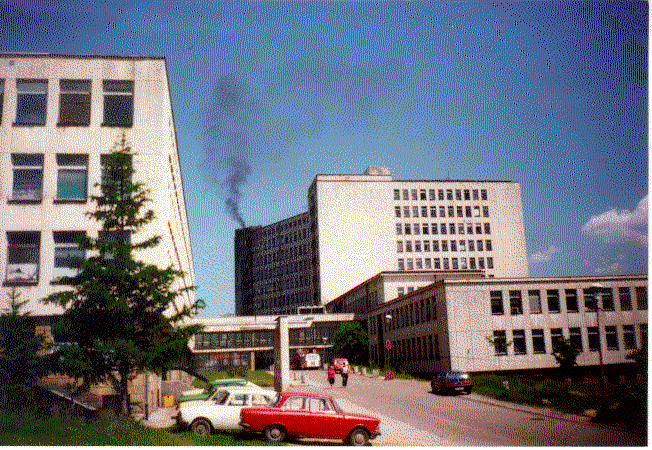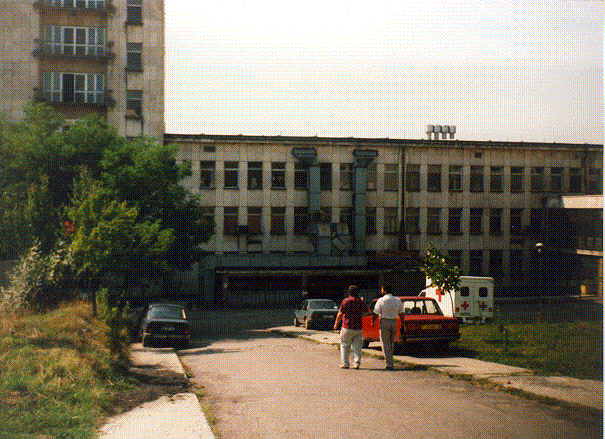
The Regional Hospital is a typical hospital facility of medium sized Bulgarian cities. Its structure consists of two 11 story main buildings, one three story building adjacent to the main building and one 4 story standalone building. The hospital building is 29 years old. It was constructed in 1967, and additional parts were built in the next years. The current hospital capacity is 761 beds, with 2 to 4 in each patients room. The hospital employs a medical, administrative and operational staff of 884 people. A sketch of the main blocks of the hospital is shown in Fig.1.1.

we can change afterwards.......
The total gross floor area of the buildings is 223198.74 ft2 and the net floor high is 10.5 ft. The existing constructive documentation and drawings are uncompleated and do not reflect the different changes in the rooms and stores that have been made during the years. An examination of all premises and rooms has been done during the audit and as a result schematics of all stores and rooms corresponding to the current situation in the hospital have been prepared as shown in Application. The hospital complex has been chosen as a representative one for energy analysis under an USAID Energy Efficiency improvement program. The purpose is to assist the hospital in utilizing its energy resources more efficiently. It is intended to serve as a model for similar facilities throughout the region and country. Objectives: Provide management with better information concerning energy use and energy costs; Identify and quantify the energy saving opportunities and energy conservation measures (ECMs); Develop action plan for implementation; Propose a list of ECMs to be considered for demonstration installation, sponsored by USAID; Win management commitment for implementation. The following sequence of actions has been included in the audit works: subsystem oriented data collection and measurements; active designed experiment comprising hourly measurements of representative parameters in all subsystems; heat balance prepereing; energy consumption data analysis; building modeling using ASEAM3.0; additional energy data collection; analysis of energy conservation measures; economic evaluation of ECMs. selection of ECMs for demonstration implementation; price information and quotations for selected ECMs collection.

we can change afterwards.......
Gabrovo has typical sub-mountain climate. It is situated in central Bulgaria and its geografical coordinates are 42.3 North wight and 23.7 East lenght. The required climate data for energy building simulation were provided as an ASEAM 3.0 formated file by USAID. The data file is created on the base of hourly climate satelite measurements for 1995 done by NASA.

we can change afterwards.......
The building have brick walls 35 cm thick The windows are double, wooden, with two or three wings.
A Simplified Energy Analysis Method, Version 3.0 (ASEAM3.0), is a modified bin method (ASHRAE) program for calculating the energy consumption of residential and simple commercial buildings. ASEAM3.0 runs on an IBM PC and compatibles with at least 256 kilobytes of memory and a hard disk.
Like most building energy analysis program, ASEAM3.0 performs calculations in four segments:
Loads: Thermal heating and cooling loads (both peak and “diversified”, or average) are calculated for each zone by month and outside bin temperature. Lighting and miscellaneous electrical consumption is calculated in the loads segment.
System: The thermal loads calculated in the loads segment are then passed to the system segment, which calculates “coil” loads for boilers and chillers. Note that the system coil loads are not equal to the zone loads calculated above owing to ventilation requirements, latent cooling, humidification requirements, economiser cycles, reheat, mixing, etc. Some building energy requirements are calculated in the system segment (e.g., heat pump and fan electricity requirements).
Plant: All of the systems coil loads on the central heating and cooling plant equipment are then combine, and calculations are performed for each central plant type. Note that plant equipment can also impose loads on other plant equipment, such as cooling tower loads from chillers and boiler loads from absorption chillers or domestic hot water. The results of the plant calculation are monthly and annual energy consumption for each plant type.
Economic (optional): Energy consumption for all the building end-used categories is then totalled and reported. If specified, the life-cycled costs of the total energy requirements, combined with other parameters, are calculated and reported. Comparisons of base case with alternative cases may also be performed in the parametric and ECO calculation modes.
| Energy Audit |
| Evaluation of Results |